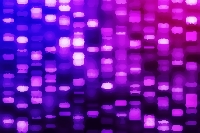Article by Guest Blogger, Mike Murray - WAGS London & South East England Group Joint Convenor and DNA enthusiast.
What's this about? 
Join me on a personal journey of discovery.
I've just ordered a DNA testing kit for both Lesley and me, so we're now waiting for the package to arrive so that we can join the many thousands chasing their ancestry using DNA. Over the next little while I'll post the occasional blog reporting progress and what I learn from this process.
Why now?
I've been interested in the subject for quite a few years now. I remember attending a DNA lecture and giving a mouth swab at the Melville LDS Family History Centre many years ago. This was for the Sorenson Molecular Genealogy Foundation whose aim was to collect DNA samples and 4-generation family trees from about 100,000 people world-wide. They were going to try and create huge interlinked trees, to show how all the peoples of the world are related. As it happened, the Sorensen database was sold to Ancestry some time ago, so I'm not sure what happened to my tree that I submitted. I'll try and find out during this journey.Recently at a WAGS discussion about the subject, a number of people were explaining the DNA tests they had and the results they were getting. There was a fair bit of confusion (and interest) about the subject, and some worthwhile results coming through. And so I decided to get involved and go get another test.
The recently introduced autosomal ˜Family Finder' test from Familytreedna in the great big US of A. There are lots more samples now to match with so there's a greater chance I'll find some relatives, and this new test covers a sample of the whole genome (not just the Y-chromosome). So far as I know, no-one in Australia offers autosomal tests, so if you want one, you gotta go offshore.
Another reason for my new interest in doing this test is to become more knowledgeable from a practical and personal sense. Although I've given lots of talks about the topic, I was piqued when I received an email recently from someone asking about testing and she said: I am interested in having my DNA tested, but am having difficulty finding anyone in Australia who has actually been through the process (I'm sure there must be many). Â As with most things today there seems to be a number of providers but for me trying to ID a legitimate provider or a preferred test and understand what I'm actually paying for is a bit of a struggle.
So, let's see what we can do to help over the next little while.
DNA - what is it?
We are all unique, and our cells contain copies of the DNA that spells out how to construct each one of us. About 99.9% of my DNA is the same as yours, but it's the 0.1% difference that is useful in working out family history. I won't try and explain it all but if it's something that confuses you, have a look at the simple animations at this site: www.smgf.org/pages/animations.jspx
And a nice person called Kelly Wheaton has produced a Beginner's Guide to genetic genealogy; it's here https://sites.google.com/site/wheatonsurname/beginners-guide-to-genetic-genealogy
DNA tests - a refresher
In essence there are three types of DNA tests that are useful for genealogy:
The Y chromosome test (Y-STR), which has been around for years. Because the Y chromosome is passed on from father to son with very little change (it is the .˜male' chromosome and doesn't go through .˜recombination') this test can only be conducted for males. It is very useful for tracing relatives on the father's father's father's line, or the "surname" line in societies like ours. Markers along non-coding stretches of the DNA are tested and the number of STRs (Short Tandem Repeats) at each marker is counted. Usually 37, 67 or even more markers are tested. Older tests were for 12 or 25 markers, which isn't really sufficient to be very useful. If there's a close match with someone, the common ancestor could be many generations in the past. Or it could be your Grand-dad. The Y test is excellent for disproving relationships.
Mitochondrial DNA test (mtDNA), again has been around for a long time. Mitochondrial DNA is a separate (and much smaller) sequence of DNA contained in the energy organelles in your cells and is passed on from mother to all her children. So the genealogical information from this test is only relevant in tracing your mother's mother's mother's line. If there's a match the common ancestor might be many hundreds or even thousands of years ago. There is a recent refinement now to the old mtDNA test, which tests the full genomic sequence, which is much more useful for genealogy. The suppliers claim that matches have a 50% chance of sharing a common maternal ancestors within the last 5 generations. Again, mtDNA tests are great for disproving relationships.
Autosomal DNA test (atDNA) is new and focuses on a large number of specific areas across the full genome. The theory is that relatively large sequences of DNA remain "unshuffled" during the recombination process that occurs each generation/conception. By analyzing enough locations across all the chromosomes (about 700,000 pairs of data points) the programs can calculate the degree of relationship between two people. This is the Family Finder test that we've ordered.
What next?
We expect the kits very soon. From the information we've received it's a simple mouth swab. I'll report on the process when they arrive. And then the results when they come in.
Stay tuned!
Mike

